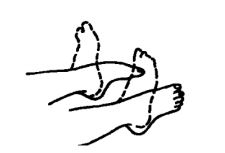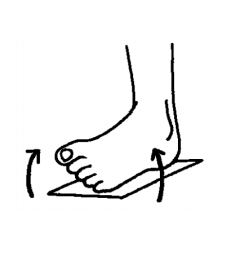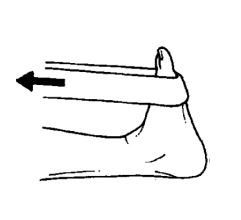Download and print as a PDF (207kB pdf)
On this page
What is an ankle sprain?
An ankle sprain is one of the most common types of soft tissue injury.
It occurs when the foot is moved through a greater range of movement than normal. This stretches and weakens the soft tissues and ligaments that support the ankle.
The main symptoms are:
- Pain
- Swelling
- Bruising
- Difficulty moving the ankle normally
How long will it take to recover?
- The initial pain usually settles after a few days and during this time it is important to follow the simple treatment advice in this leaflet to ensure a good recovery.
- The soft tissues (muscles and ligaments) normally take around six weeks to heal, this time frame may vary as everyone recovers from injuries at different rates and some sprains can be worse than others.
- You are more likely to sprain your ankle if you have sprained it before and it isn’t fully healed. Be careful on uneven surfaces, going up and down stairs, and walking in shoes that are not supportive.
What treatments can I use?
Painkillers
If your doctor has prescribed painkillers, then these should be taken at the recommended dose. Non-steroidal antiinflammatory drugs are usually prescribed but they are not suitable for everyone so please speak with your doctor before using them.
Cold packs
A cold pack (an ice pack or frozen peas wrapped in a damp towel) can also provide short-term pain relief. Apply to the sore area for up to 15 minutes, every few hours.
Rest
Try to rest the foot for the first 24 to 72 hours. However, it is important to maintain flexibility in the ankle so you can gently move it without causing too much pain. This will ensure your ankle does not become too stiff and it will help the healing process.
Elevation
Raise your ankle above the level of your hips to reduce swelling. You can use pillows to keep the foot up.
Early movement and exercise
Early weight bearing (putting weight through your injured foot) has been shown to help your ankle heal more quickly. For this reason most people with an ankle sprain will not be given crutches.
Bandage
- We no longer bandage ankle sprains as this doesn’t reduce pain nor improve recovery time and may actually delay your time to full recovery.
- Try to walk as normally as possible as this will help your recovery.
What should I avoid?
In the first 48 hours after injury avoid the following as they might make your symptoms worse:
- Hot baths or showers
- Heat packs or heat rubs
- Drinking alcohol
- Massage
Exercises for your ankle
1. Point your foot up and down.

2. Make circles with your foot.
Change direction.

3. Place your foot on the floor. Rock your foot from side to side, lifting the inner and then outer border of your foot.

4. Sit with your leg straight out in front of you. Put a towel round your foot and pull it up towards you. Feel a stretch in the back of your calf.

Please note: These exercises should not increase your pain. Perform each exercise gently and slowly, only moving as far as feels comfortable. Practice each exercise up to ten times, at two or three times per day.
General advice
- Keep your ankle moving, as pain allows.
- The sooner you start early exercise, the better your recovery.
- Once you have recovered, continue to keep your body healthy with exercise.
- Strengthen your ankles to prevent future injuries.
When should I seek help?
- The length of time it takes for your ankle to recover depends on the severity of the original injury. It can take a few months to regain full function but your symptoms should not be worsening.
- If the pain and swelling have not shown improvement within a week and you are unable to weight-bear, please seek further medical advice from your general practitioner.
Further support
For general medical advice please use the NHS website, the NHS 111 service, walk-in-centres, or your GP.
NHS website provides online health information and guidance.
There are walk-in and urgent treatment services at Brighton Station, Crawley Urgent Treatment Centre, Lewes Victoria Hospital, Horsham Minor Injuries Unit and Bognor Regis War Memorial Hospital.
The information in this leaflet is for guidance purposes only and is in no way intended to replace professional clinical advice by a qualified practitioner.